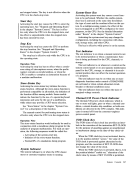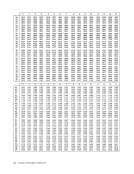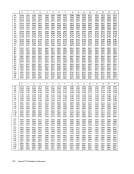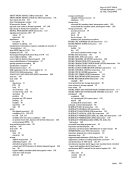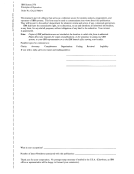Upon Termination
When
of Operation at
During ByI/O Subchannel Sub- Control I/O Command By SIO By By HID Inter- Status
WhenI/O Is Idle is Working channel Unit Device Chaining or SIOF ByTIO CLRIO+ or HDV ruption
Attention
Status modifierC* Control unit end C* Busy Channel end C* C*H Device end C* Unit check C C C Unit exception
Program-controlled
interruptionC* C C C* Incorrect length C C Program check C C Protection check C C Channel data check C C Channel control check C* C* C* C* I nterface control check C* C* C* C* Chaining check C C Deferred condo code 1
Deferred condo code 3
Explanation:C S The channel or device can create or present the status
condition at the indicated time. ACSW or its status
portion is not necessarily stored at this time.
Conditions such as channel end or device end are
created at the indicated time.Other conditions may
have been created previously, but are made accessible to
the programonly at the indicated time. Examples of
such conditions are program check and channel data
check, which are detected while data is transferred, but
are madeavailable to the program only with channel end,
unless thePCI flag or equipment malfunctioning have
caused an interruption condition to be generated earlier.
The status indication is stored in theCSW at the
indicated time.
An
been created previously. Theletter.f. appearing with the
exist previously in the form that causes the program to be
alerted, and may have been created by theI/O instruetion
orI/O interruption. For example, equipment malfunctioning may be detected during an I/O interruption, causing
channel or interface control check to be indicated; or a
device such as the2702 may signal the control-un it-busy
condition in response to interrogation by anI/O instruction,
causing status modifier, busy, and control unit end to be
indicated in theCSW. Contents of the CSW Status Fields
theCPU to which the channel is configured. The
information stored by theSTORE CHANNEL ID
instruction implies whether theIOEL is used and, if
it is used, specifiesthe maximum full-channel-logout
length.C* C C* C C C* C* #
H
+C* S S S S C CS CS S CS S CS CS S CS S C CS CS S CS S C*+ CS+ S S S C+ CS+ S S S C* CS CS S CS C* CS S S S C CS S S S S S S C* CS S S S C* CS S S S S S S C* CS CS CS CS CS C* CS CS CS CS CS S S S C*# S S S C*# S S S The status condition generates an interruption condition. Channel end and device end do not result in interruption
conditions when command chaining is specified and no
unusual conditions have been detected.
This indication is created at the indicated time only by
an immediate operation.Applies only to SIOF. When an operation on the selector channel has been
concluded by HALTDEVICE or HALT I/O, or an
operation has been concluded byCLEAR I/O, channel
end indicates the concluding of the data-handling portion
of the operation at the control unit.
The entries in this column applyonly when the CLRIO function is executed. When CLEAR I/O is executed as
TESTI/O, the entries in the TIO column apply. 110 Communications Area
Reallocations 160-191 of theCPU to which the
channel is configured comprise a permanently as
signed area of main storage used forI/O, designated
theI/O communications area (lOCA). Input/Output Operations 239
When
of Operation at
During By
When
Attention
Status modifier
Program-controlled
interruption
Deferred condo code 3
Explanation:
condition at the indicated time. A
portion is not necessarily stored at this time.
Conditions such as channel end or device end are
created at the indicated time.
have been created previously, but are made accessible to
the program
such conditions are program check and channel data
check, which are detected while data is transferred, but
are made
unless the
caused an interruption condition to be generated earlier.
The status indication is stored in the
indicated time.
An
been created previously. The
exist previously in the form that causes the program to be
alerted, and may have been created by the
or
channel or interface control check to be indicated; or a
device such as the
condition in response to interrogation by an
causing status modifier, busy, and control unit end to be
indicated in the
the
information stored by the
instruction implies whether the
it is used, specifies
length.
H
+
conditions when command chaining is specified and no
unusual conditions have been detected.
This indication is created at the indicated time only by
an immediate operation.
concluded by HALT
operation has been concluded by
end indicates the concluding of the data-handling portion
of the operation at the control unit.
The entries in this column apply
TEST
Reallocations 160-191 of the
channel is configured comprise a permanently as
signed area of main storage used for
the
























































































































































































































































